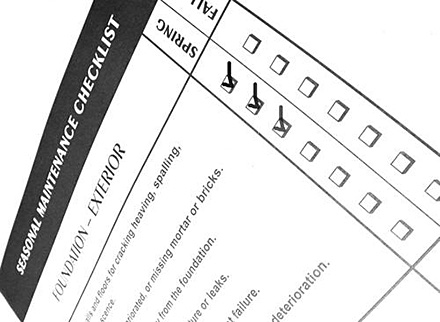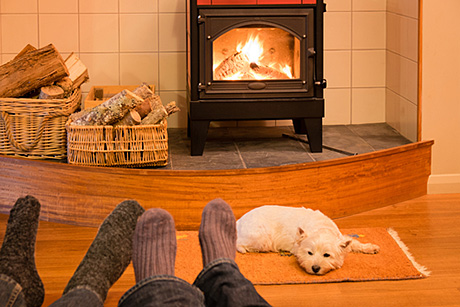|
In this issue:
Will the New Tax Law Affect Your Paycheck?
Spring Home Maintenance - A Checklist
Tips for Your Winter Staycation
| Will the New Tax Law Affect Your Paycheck? |
| |
It's 2018, and the tax-overhaul plan signed into law by President Trump on December 22 has officially gone into effect. The first paychecks of the year are starting to roll in, but don't expect to see changes to your paycheck right away. The IRS is still working to develop withholding guidance, and it's not expected to issue that guidance until sometime in January. Once it does, the IRS is encouraging employers and payroll service providers to implement the new rules by February - so employees should start seeing changes then.
 "The IRS emphasizes this information will be designed to work with the existing Forms W-4 that employees have already filed, and no further action by taxpayers is needed at this time," the agency said in a statement. "The IRS emphasizes this information will be designed to work with the existing Forms W-4 that employees have already filed, and no further action by taxpayers is needed at this time," the agency said in a statement.
What happens after that will depend greatly on your income, where you live, and your tax situation: Are you married? Do you have children? Do you itemize? But tax experts warn that the change may not be very noticeable for many income brackets. In an interview with Reuters, Pete Isberg, an executive at ADP, said: "When the taxes are reduced by 1 to 3 percent, that's not going to be a huge noticeable difference. It's not going to be hundreds of dollars."
For instance, a tax cut of $1,000 a year will amount to an extra $38 in each paycheck for a typical employee paid biweekly.
Bottom line for now: Employees are encouraged to "stay put" for the first few weeks of January, Reuters reports - that is, don't go in and adjust your W-4 withholdings. Wait until the IRS releases its guidance.
In the meantime, there are plenty of paycheck calculators out there that estimate how much of a tax cut you'll get - if any - after the changes, but they're only estimates based on hypothetical tax situations. CNN has one here. The Washington Post has one here. The New York Times has one here. Have at 'em!
Article courtesy of Fastcompany.com
Back To Top
|
| Spring Home Maintenance - A Checklist |
| |
With the days lengthening and weather warming, spring is a good time to get outdoors and tackle some larger home projects. Now that the threat of winter storms has passed, you can look for damage and make any needed repairs, as well as prep your home and garden for summer. We spoke with an expert to get helpful tips on what to watch for this season, from proper irrigation to mosquitoes and termites (oh my!).
 1. Clean gutters and downspouts. After the last frost has passed, it's important to have your gutters and downspouts cleaned and repaired. "Clogged gutters and downspouts can cause the wood trim at the eaves to rot, and that can invite all kinds of critters into your attic space," says Victor Sedinger, certified home inspector and owner of House Exam Inspection and Consulting. 1. Clean gutters and downspouts. After the last frost has passed, it's important to have your gutters and downspouts cleaned and repaired. "Clogged gutters and downspouts can cause the wood trim at the eaves to rot, and that can invite all kinds of critters into your attic space," says Victor Sedinger, certified home inspector and owner of House Exam Inspection and Consulting.
Having your gutters and downspouts cleaned early in the season can also help prevent damage from spring rains. "Gutters and downspouts should be clean and running free," Sedinger says. "If your downspouts are installed properly, water is diverted away from the house so that no water collects around your foundation."
2. Reseal exterior woodwork. Wood decks, fences, railings, trellises, pergolas and other outdoor structures will last longer and stay in better condition if they're stained or resealed every year or two. Take this opportunity to make any needed repairs to woodwork as well.
3. Check for signs of termites. Beginning in March and going through May or June, be on the lookout for these winged insects. "Termites swarm in the spring," Sedinger says. "If there's a bunch of winged insects flying out of a hole in the woodwork, that's probably termites. Call a licensed professional pest control company. You'll save money and trouble in the long run."
4. Inspect roof. Winter storms can take quite a toll on the roof. When spring arrives, start by making a simple visual inspection of your roof. "It doesn't require a ladder, and you certainly don't have to get on a roof to look," Sedinger says. "Use binoculars or a camera or smartphone with a telephoto feature if you need to." Look for missing shingles, metal pipes that are damaged or missing or anything that simply doesn't look right. If you notice anything that needs closer inspection or repair, call a roofer.
5. Paint exterior. If you're planning to repaint your home's exterior this year, spring is a good time to set it up. Want to paint but can't decide on a color? Explore your town and snap pictures of house colors you like, browse photos on Houzz or work with a color consultant to get that just-right hue.
6. Inspect driveways and paths. Freezing and thawing is rough on concrete, asphalt and other hardscaping materials. Take a walk around your property to look for damage to walkways, paths and driveways, and schedule repairs as needed. Asphalt can often be patched, but damaged concrete may need to be replaced entirely.
7. Check sprinkler and irrigation systems. Checking your sprinklers or irrigation systems in the spring can save water - and save your plants. Sedinger shares these tips for checking your watering system:
- Run the system through all the zones manually and walk the property.
- Make sure none of the heads are broken or damaged.
- Adjust any heads that are spraying the house, especially windows, as this can cause moisture problems.
- Adjust heads that are spraying the street, sidewalk or porches to avoid wasting water.
- If you don't know how to maintain your sprinkler system, call a professional to do it. You'll save money on your water bill and protect one of our most valuable natural resources.
8. Prevent mosquitoes. In recent years, we've become more aware of the potential danger mosquitos can pose to our health. "West Nile virus and Zika virus are just the latest diseases caused by these winged pests," Sedinger says. The best way to prevent mosquitos around your home is simply by getting rid of any standing water. "Walk around your property [and peek at your neighbors]. If you see anything or any area where water stands, fix it, tip it, get rid of it or maintain it regularly," Sedinger says.
9. Check screen doors and windows. Screens are designed to let the breeze flow in and keep bugs out - but they can only do their job if they're free from holes and tears. Before setting up your screens for the warm months ahead, be sure to carefully check each one and repair any holes or tears, no matter how small. You can find screen repair kits at most hardware and home improvement stores.
10. Schedule air-conditioning service. "Home inspectors see a lot of air-conditioning systems that are just not taken care of," Sedinger says. "Just because it gets cool doesn't mean it's working efficiently." To get the longest life out of your cooling system and keep it running as efficiently as possible, change the filters at least once each season, and hire a licensed professional to service the equipment before the start of summer.
Article courtesy of Familyhandyman.com
Back To Top |
| Tips for Your Winter Staycation |
| |
 Many families take advantage of winter to get out of the cold and take a vacation to visit somewhere warmer. Unfortunately, for some families, taking a vacation, especially around the holidays just isn't in the budget. Though staying home during the cold winter months may not seem like much of a vacation, there are many benefits to a staycation: You save money You get the opportunity to learn more about your area There's no packing and unpacking The money you spend stays local, which helps support the local economy Strengthen bonds and connections with each other You don't need to spend a lot of money or travel far to enjoy fun activities and create memories as a family. Though you may be tempted to get done some of your projects or chores you've been putting off, instead use the time to really enjoy each other. Many families take advantage of winter to get out of the cold and take a vacation to visit somewhere warmer. Unfortunately, for some families, taking a vacation, especially around the holidays just isn't in the budget. Though staying home during the cold winter months may not seem like much of a vacation, there are many benefits to a staycation: You save money You get the opportunity to learn more about your area There's no packing and unpacking The money you spend stays local, which helps support the local economy Strengthen bonds and connections with each other You don't need to spend a lot of money or travel far to enjoy fun activities and create memories as a family. Though you may be tempted to get done some of your projects or chores you've been putting off, instead use the time to really enjoy each other.
Here are some fun staycation ideas:
- Explore your community - See if there are any events happening right in your own town.
- Visit a local museum or aquarium - Use this as an opportunity for your family to learn about something new, or learn more about something your passionate about.
- Enjoy the outdoors - Explore the parks and trails in your area. Go for a walk as a family. Has it snowed recently? Play in the snow, have a snowman building contest or go sledding.
- Learn something new - Take a class or learn a new skill together as a family.
- If you'd rather stay warm, find a fun indoor activity. Visit an indoor play gym, go bowling or go see a movie the whole family will enjoy!
- Keeping things on a budget? Turn your living room or play room into your own personal movie theater or bowling alley!
- Get crafty. From painting, coloring and drawing to creating presents for family members and friends, the options for an arts and crafts play date are endless! For the older children, you can incorporate reading and writing in their arts and crafts projects while still making sure everyone is having fun.
- Enjoy a meal as a family - Not only can you sit down and have dinner together, consider preparing your meal together as well. Things may get messy, but get the children involved and head into the kitchen for some cooking fun! Create some special treats by baking and decorating cookies or enjoy homemade pizzas and have the children help make the dough and put on the different toppings they want.
Staycations can be a fun and unique time to bond as a family, so use these little day trips to your advantage. Take the time to plan what you'll be doing on your staycation so you aren't sitting around staring at each other instead of having fun!
What are some of your family's favorite staycation activities?
Article courtesy of Educationalplaycare.com
Back To Top |
|

 "The IRS emphasizes this information will be designed to work with the existing Forms W-4 that employees have already filed, and no further action by taxpayers is needed at this time," the agency said in a
"The IRS emphasizes this information will be designed to work with the existing Forms W-4 that employees have already filed, and no further action by taxpayers is needed at this time," the agency said in a  1. Clean gutters and downspouts. After the last frost has passed, it's important to have your gutters and downspouts cleaned and repaired. "Clogged gutters and downspouts can cause the wood trim at the eaves to rot, and that can invite all kinds of critters into your attic space," says Victor Sedinger, certified home inspector and owner of House Exam Inspection and Consulting.
1. Clean gutters and downspouts. After the last frost has passed, it's important to have your gutters and downspouts cleaned and repaired. "Clogged gutters and downspouts can cause the wood trim at the eaves to rot, and that can invite all kinds of critters into your attic space," says Victor Sedinger, certified home inspector and owner of House Exam Inspection and Consulting. Many families take advantage of winter to get out of the cold and take a vacation to visit somewhere warmer. Unfortunately, for some families, taking a vacation, especially around the holidays just isn't in the budget. Though staying home during the cold winter months may not seem like much of a vacation, there are many benefits to a staycation: You save money You get the opportunity to learn more about your area There's no packing and unpacking The money you spend stays local, which helps support the local economy Strengthen bonds and connections with each other You don't need to spend a lot of money or travel far to enjoy fun activities and create memories as a family. Though you may be tempted to get done some of your projects or chores you've been putting off, instead use the time to really enjoy each other.
Many families take advantage of winter to get out of the cold and take a vacation to visit somewhere warmer. Unfortunately, for some families, taking a vacation, especially around the holidays just isn't in the budget. Though staying home during the cold winter months may not seem like much of a vacation, there are many benefits to a staycation: You save money You get the opportunity to learn more about your area There's no packing and unpacking The money you spend stays local, which helps support the local economy Strengthen bonds and connections with each other You don't need to spend a lot of money or travel far to enjoy fun activities and create memories as a family. Though you may be tempted to get done some of your projects or chores you've been putting off, instead use the time to really enjoy each other.